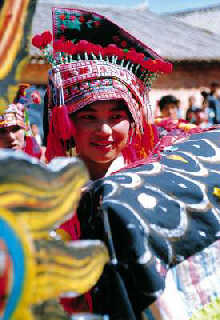 With a population of 6,572,173 (as of 1990), the Yi ethnic minority is mainly scattered in Yunnan, Sichuan, Guizhou provinces and Guangxi Zhuang Autonomous Region, in which Liangshan Yi Autonomous Prefecture in Sichuan province holds the single largest Yi community in China.
With a population of 6,572,173 (as of 1990), the Yi ethnic minority is mainly scattered in Yunnan, Sichuan, Guizhou provinces and Guangxi Zhuang Autonomous Region, in which Liangshan Yi Autonomous Prefecture in Sichuan province holds the single largest Yi community in China.
The Yi language belongs to the Tibeto-Burman Austronesian of the Chinese-Tibetan Phylum, and the Yis speak six dialects. Many Yis in Yunnan, Guizhou and Guangxi know the Han (standard Chinese or Mandarin) language. The Yis used to have a syllabic script called the old Yi language, which was formed in the 13th century. It is estimated that the extant old Yi script has about 10,000 words, of which 1,000 are words of everyday use. Since the old Yi language is not consistent in word form and pronunciation, it was reformed for use in books and newspapers in 1957.
The ancestors of the Yi ethnic minority can be traced back to the Qiang people living in northwest China. They later migrated south and joined the local southwest aboriginal and created a new group -- the Yi ethnic minority.
In the Eastern Han (25-220), Wei (220-265) and Jin (265-420) dynasties, inhabitants in these areas came to be known as "Yi". In the past, most Yis called themselves "Luoluo", although many different appellations existed. After liberation, following consultation with the ethnic minority, it agreed upon the official name of the Yi ethnic minority.
Most Yi people are engaged in agriculture and a small percentage of them raise livestock. Their traditional fine arts include painting, sculpture, lacquer painting and embroidery, etc. The Yi culture has a long history. A number of works of history, literature and medicine as well as calendar written in the old Yi script are still seen in most Yi areas, which are of great significance. A famous poem calledA Shimais one representative literary works of the Yis. In the story, a girl named A Shima fought for her free love and was killed by flood. A Shima turned into stone carving in legend, but her love story has spread all over China.
Group dance is popular in Yi region. The participators stand in a circle, hands in hands, dancing accompanied by reed and other music instruments.Tiao Yueis a famous dance of the Yi people.
The Yi people used to believe in many gods and worshiped ancestors. Some people who live with Han people also believe in Buddhism and Taoism, and few believe in Catholicism and Christianity.
Yi people have many traditional festivals, of which the most important include the Torch Festival and the October New Year.
